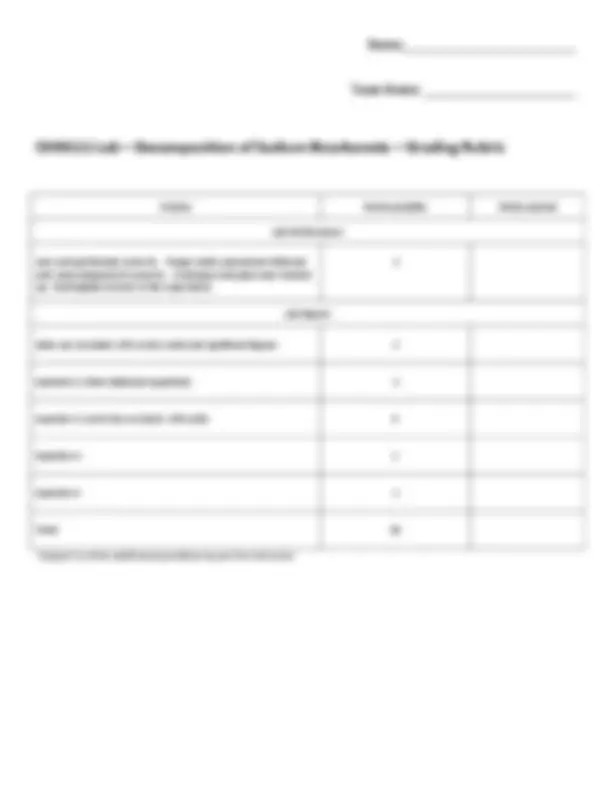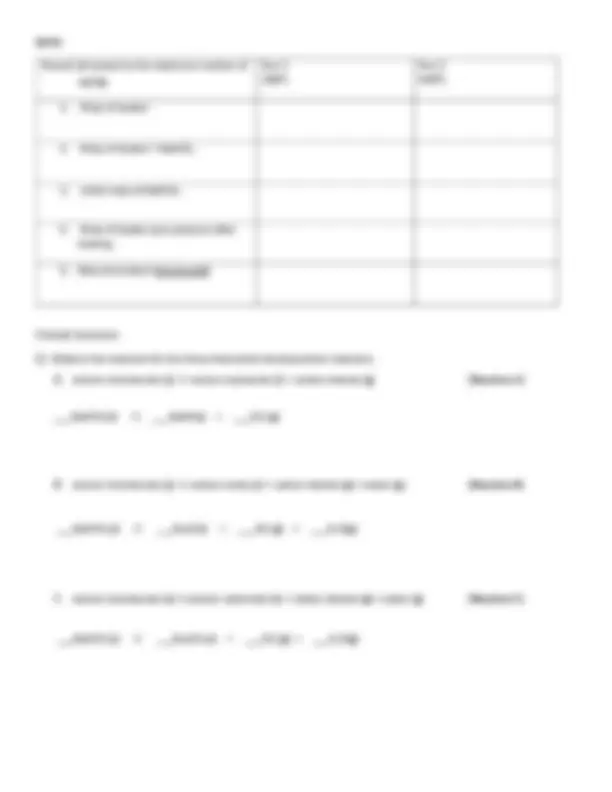





Study with the several resources on Docsity

Earn points by helping other students or get them with a premium plan


Prepare for your exams
Study with the several resources on Docsity

Earn points to download
Earn points by helping other students or get them with a premium plan
Community
Ask the community for help and clear up your study doubts
Discover the best universities in your country according to Docsity users
Free resources
Download our free guides on studying techniques, anxiety management strategies, and thesis advice from Docsity tutors
Sodium bicarbonate decompostion into sodicum carbonate, water and carbon diaxoide. Complete lab manul with worksheet.
Typology: Lab Reports
1 / 7

This page cannot be seen from the preview
Don't miss anything!




Goal: To experimentally determine decomposition reaction of sodium hydrogen carbonate on reaction stoichiometry. Introduction Stoichiometry is the study of mass relationships in chemistry. In this lab, you will decompose baking soda (sodium hydrogen carbonate or sodium bicarbonate) and use the mass relationships to determine how baking soda decomposes. Baking soda is commonly used in baking to provide a “rise” to baked goods. When baking soda decomposes it produces a gas (carbon dioxide) which is trapped in pockets and giving the baked goods an airy texture. Sodium bicarbonate may be more familiar to you as baking soda. There are three theoretically possible chemical reactions that could occur during the thermal decomposition of baking soda.
By comparing the theoretical yields of the possible solid products with the actual experimental yield of the product, you will be able to determine which of the above decomposition reactions occurred. In this experiment, you will determine the products from the thermal decomposition of sodium bicarbonate. The experiment is straightforward. A sample of sodium bicarbonate is weighed and heated. The final product will be weighed and the mass of product will be compared to the theoretical yield of the three possible products to determine how sodium bicarbonate decomposes, and whether its decomposition gives different products when heated to a low temperature versus a high temperature. Laboratory Activity Equipment hot plate analytical top-loader balance clean dry beaker Beaker tongs Chemicals NaHCO 3 (s) Safety Hazards – Caution – hot plates are hot! Even when they may not look hot. When determining if a beaker is still hot, slowly bring the back of your fingers towards it. If you sense any heat radiating from the beaker, do not touch, wait! PROCEDURE
weights.
Record all masses to the maximum number of sig figs Run 1 200°C Run 2 400°C
___NaHCO 3 (s) → ___NaOH(s) + ___CO 2 (g)
___NaHCO 3 (s) → ___Na 2 O(s) + ___CO 2 (g) + ___H 2 O(g)
___NaHCO 3 (s) → ___Na 2 CO 3 (s) + ___CO 2 (g) + ___H 2 O(g)
from each of the possible decomposition reactions, then calculate the percent yield by dividing your actual yield by the theoretical yield you calculate for each reaction. Percent yield = | 𝑎𝑐𝑡𝑢𝑎𝑙 𝑦𝑖𝑒𝑙𝑑 𝑡ℎ𝑒𝑜𝑟𝑒𝑡𝑖𝑐𝑎𝑙 𝑦𝑖𝑒𝑙𝑑|^ x 100 Reaction A ___NaHCO 3 (s) → ___ NaOH(s) + ___CO 2 (g) Run 1: Initial grams of NaHCO 3 = __________________ Theoretical yield (grams) of NaOH:___________ Percent yield (Run 1) = ____________________ Run 2: Initial grams of NaHCO 3 = __________________ Theoretical yield (grams) of NaOH:___________ Percent yield (Run 2) = ____________________ Reaction B ___NaHCO 3 (s) → ___ Na 2 O(s) + ___CO 2 (g) + ___H 2 O(g) Run 1: Initial grams of NaHCO 3 = __________________ Theoretical yield (grams) of Na 2 O:___________ Percent yield (Run 1) = ____________________
What about during Run 2 (heated to 400°C)? Did they form the same product, or different products? Was this expected or unexpected? Explain briefly.